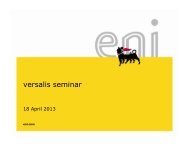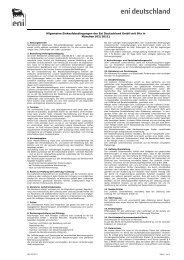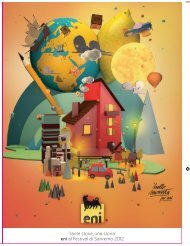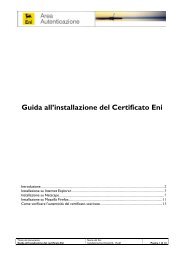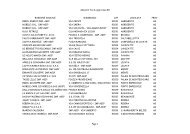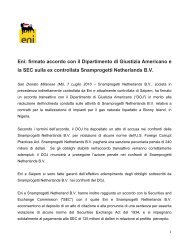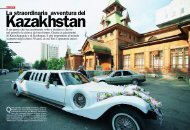È in corso il restauro conservativo del Duomo di Milano. Un ... - Eni
È in corso il restauro conservativo del Duomo di Milano. Un ... - Eni
È in corso il restauro conservativo del Duomo di Milano. Un ... - Eni
You also want an ePaper? Increase the reach of your titles
YUMPU automatically turns print PDFs into web optimized ePapers that Google loves.
FOCUS<br />
problematiche sociali. Come non ricordare <strong>il</strong> Card<strong>in</strong>ale Alfredo<br />
Ildefonso Schuster, che – proprio <strong>in</strong> <strong>Duomo</strong>, nella<br />
sua omelia <strong>del</strong>la prima <strong>di</strong> Domenica <strong>di</strong> Avvento <strong>del</strong> 1938 –<br />
si oppose con forza alle leggi razziali, pubblicate con Regio<br />
decreto solo quattro giorni più tar<strong>di</strong> (<strong>il</strong> 17 novembre). E<br />
ancora <strong>il</strong> suo animo turbato per i bombardamenti <strong>del</strong>l’agosto<br />
1943, sulla città già a lungo provata, che non avevano<br />
risparmiato nemmeno la Cattedrale. Come scriveva nel<br />
1963 Papa Paolo VI, che da Arcivescovo <strong>di</strong> M<strong>il</strong>ano aveva<br />
conosciuto ed amato la Cattedrale: nel <strong>Duomo</strong> dunque «è<br />
la fede <strong>di</strong> un popolo che si esprime […], è tutta una comunità,<br />
è tutta una società, è tutta una storia». Ecco riaffiorare<br />
poi <strong>il</strong> ricordo dei funerali, nel 1969, per la strage <strong>di</strong> Piazza<br />
Fontana e, solo ventiquattro anni dopo (nel 1993),<br />
quelli <strong>del</strong>le vittime <strong>del</strong>la bomba <strong>di</strong> via Palestro.<br />
Anche i giorni a noi più vic<strong>in</strong>i sono carichi <strong>di</strong> avvenimenti<br />
che trovano la loro cornice nel <strong>Duomo</strong>, Cattedrale <strong>di</strong> dolore<br />
e <strong>di</strong> gioia, dove rivivere l’agonia e la morte <strong>del</strong>l’amato<br />
Giovanni Paolo II e l’elezione <strong>di</strong> Papa Benedetto XVI. Le<br />
campane, le tre gran<strong>di</strong> campane <strong>del</strong> <strong>Duomo</strong>! Le vibrazioni<br />
che generano sulla struttura <strong>del</strong> tiburio non permettono <strong>di</strong><br />
suonarle a lungo, ma non possiamo <strong>di</strong>menticare la struggente<br />
vibrazione che <strong>il</strong> campanone – nella tarda serata <strong>di</strong><br />
sabato <strong>di</strong> 2 apr<strong>il</strong>e <strong>del</strong>lo s<strong>corso</strong> anno – ha risvegliato nel<br />
cuore, annunciando la morte <strong>di</strong> Papa Giovanni Paolo II e<br />
chiamando, prima <strong>in</strong> piazza e poi all’<strong>in</strong>terno <strong>del</strong> <strong>Duomo</strong>,<br />
molte persone ad unirsi alla preghiera <strong>del</strong> Card<strong>in</strong>ale Arcivescovo.<br />
E ancora, <strong>il</strong> giorno seguente, l’Eucaristia <strong>di</strong> suffragio<br />
vedeva una folla immensa che trasformava Piazza<br />
<strong>del</strong> <strong>Duomo</strong> <strong>in</strong> una Cattedrale a cielo aperto. Inf<strong>in</strong>e, non<br />
più <strong>il</strong> solitario campanone, ma tutte e tre le campane, festosamente,<br />
davano l’annuncio <strong>del</strong>l’elezione <strong>di</strong> Papa Benedetto<br />
XVI, <strong>il</strong> pomeriggio <strong>di</strong> martedì 19 apr<strong>il</strong>e, convocando<br />
– una settimana più tar<strong>di</strong> – l’<strong>in</strong>tera Diocesi con <strong>il</strong> Card<strong>in</strong>ale<br />
Dionigi Tettamanzi per l’Eucaristia <strong>di</strong> r<strong>in</strong>graziamento.<br />
La Cattedrale non è qu<strong>in</strong><strong>di</strong> un semplice monumento, per<br />
quanto <strong>in</strong>signe: una galleria <strong>di</strong> opere d’arte f<strong>in</strong>e a se stessa,<br />
ma una realtà viva, segno <strong>del</strong>l’unità <strong>del</strong>la Chiesa ambrosiana<br />
attorno al suo Vescovo. La Cattedrale non rappresenta<br />
solo un “nob<strong>il</strong>e” spazio <strong>di</strong> <strong>in</strong>contro <strong>del</strong>le <strong>di</strong>verse realtà, ma<br />
è <strong>in</strong>nanzitutto un segno <strong>del</strong>la <strong>in</strong><strong>in</strong>terrotta storia <strong>di</strong> fede <strong>del</strong>la<br />
città, è legata all’esperienza <strong>di</strong> quanti <strong>in</strong> essa hanno so-<br />
stato <strong>in</strong> preghiera, è legata alla memoria dei santi pastori<br />
che hanno saputo essere sicuro punto <strong>di</strong> riferimento, <strong>in</strong><br />
momenti spesso <strong>di</strong>ffic<strong>il</strong>i e travagliati. Essa è <strong>il</strong> segno che<br />
“Dio è sempre rimasto con noi, presente nel centro <strong>del</strong>la<br />
nostra città me<strong>di</strong>ante <strong>il</strong> segno visib<strong>il</strong>e <strong>del</strong> <strong>Duomo</strong>. Dunque<br />
la Cattedrale – pur nelle <strong>di</strong>verse forme architettoniche che<br />
essa ha avuto lungo i secoli – è stata un richiamo costante<br />
all’amore <strong>del</strong> Signore per questo suo popolo e <strong>in</strong>vito a credere<br />
e a sperare <strong>in</strong> Lui” (C.M. Mart<strong>in</strong>i).<br />
La Chiesa Cattedrale riveste una funzione simbolica <strong>di</strong><br />
esemplarità per la Diocesi <strong>in</strong>tera: questa caratteristica la<br />
v<strong>in</strong>cola necessariamente nell’esercizio <strong>di</strong> ogni <strong>in</strong>iziativa<br />
che, almeno idealmente, deve essere orientata a produrre<br />
questo tipo <strong>di</strong> immag<strong>in</strong>e. Nei confronti <strong>del</strong>la città poi <strong>il</strong> luogo<br />
è ovviamente un polo <strong>di</strong> identificazione, appartenenza,<br />
oltre che centro <strong>di</strong> <strong>in</strong>teresse artistico e sociale, e non è<br />
possib<strong>il</strong>e pertanto immag<strong>in</strong>arne un “trattamento” con le<br />
stesse modalità con le quali vengono usati<br />
altri spazi più o meno significativi. Il<br />
<strong>Duomo</strong>, simbolo <strong>di</strong> M<strong>il</strong>ano <strong>in</strong> tutto <strong>il</strong> mondo,<br />
potrà rimanere tale solo nella misura<br />
<strong>in</strong> cui ne saranno rispettate le caratteristiche<br />
peculiari. La sua profonda valenza<br />
religiosa e, al tempo stesso, la sua importanza<br />
civ<strong>il</strong>e e sociale non sono due ambiti<br />
chiamati a contrapporsi, quasi ad elidersi<br />
a vicenda, ma – al contrario – sono due<br />
espressioni significative che chiedono <strong>di</strong><br />
essere vissute <strong>in</strong> un giusto equ<strong>il</strong>ibro ed<br />
una profonda unità.<br />
Il fe<strong>del</strong>e, ma anche <strong>il</strong> semplice turista (ogni<br />
giorno se ne contano oltre <strong>di</strong>ecim<strong>il</strong>a), che<br />
ancora oggi entra <strong>in</strong> <strong>Duomo</strong> è idealmente<br />
sp<strong>in</strong>to a percorrere le lunge navate f<strong>in</strong>o all’altare<br />
maggiore. Questo camm<strong>in</strong>o, attraverso<br />
la “selva dei c<strong>in</strong>quantadue p<strong>il</strong>astri”,<br />
ESPRESSIONI ARTISTICHE. Ogni<br />
opera decorativa <strong>del</strong>la facciata<br />
<strong>del</strong> <strong>Duomo</strong>, dalle statue agli ornati,<br />
è stata realizzata nel tempo<br />
con estrema cura e attenzione<br />
al dettaglio. Questo ha conferito<br />
al <strong>Duomo</strong> un aspetto unico al mondo<br />
e ha arricchito <strong>il</strong> patrimonio<br />
storico-artistico <strong>del</strong>la città.<br />
ARTISTIC EXPRESSION. All ornamental<br />
work <strong>in</strong> the <strong>Duomo</strong> facade, from statues<br />
to decorations, was made over time<br />
with the utmost care and attention<br />
for each deta<strong>il</strong>. This gave the <strong>Duomo</strong><br />
an appearance that is unique<br />
<strong>in</strong> the world and enhanced the city’s<br />
historical-artistic heritage.<br />
Even days closer to us are laden with events framed by the<br />
<strong>Duomo</strong>, a cathedral of pa<strong>in</strong> and joy, where one can br<strong>in</strong>g back<br />
to m<strong>in</strong>d the agony and death of beloved John Paul II and the<br />
election of Pope Bene<strong>di</strong>ct XVI. What about the bells, the<br />
<strong>Duomo</strong>’s three big bells! The vibrations they impart on the<br />
structure of the tiburio, prevent us from play<strong>in</strong>g the bells for<br />
long but we cannot forget the poignant vibration that the big<br />
bell – late <strong>in</strong> the even<strong>in</strong>g of Saturday Apr<strong>il</strong> 2 last year – stirred<br />
<strong>in</strong> our hearts by announc<strong>in</strong>g the death of Pope John Paul II and<br />
summon<strong>in</strong>g, first to the square and then <strong>in</strong>to the Cathedral, a<br />
lot of people to jo<strong>in</strong> <strong>in</strong> prayer with the Card<strong>in</strong>al Archbishop. And<br />
aga<strong>in</strong>, the day after, the Eucharist for the repose of the late<br />
pontiff’s soul drew a huge crowd that turned the Piazza <strong>in</strong>to an<br />
open-air Cathedral. And then, not the big bell alone but all the<br />
three bells, joyfully, announced the election of Pope Bene<strong>di</strong>ct<br />
XVI, on the afternoon of Tuesday Apr<strong>il</strong> 19, and summoned a<br />
week later the whole Diocese to jo<strong>in</strong> Card<strong>in</strong>al Dionigi<br />
Tettamanzi for the thanksgiv<strong>in</strong>g Eucharist.<br />
The Cathedral is therefore not just a monument, however<br />
magnificent it may be, a gallery of works of art that is an end<br />
<strong>in</strong> itself, but a liv<strong>in</strong>g reality, a sign of unity of the Ambrosian<br />
Church around its Bishop. The Cathedral does not just<br />
represent a “noble” meet<strong>in</strong>g space for <strong>di</strong>fferent realities, but it<br />
is above all a sign of the unbroken story of the city’s faith, it is<br />
bound to the experience of all those who have paused to pray<br />
<strong>in</strong> it, it is bound to the memory of the sa<strong>in</strong>tly pastors who<br />
knew how to be a sure reference po<strong>in</strong>t <strong>in</strong> often <strong>di</strong>fficult times.<br />
It is the sign that “God has always rema<strong>in</strong>ed amidst us,<br />
present <strong>in</strong> the centre of our city through the visible sign of the<br />
<strong>Duomo</strong>. Then the Cathedral – regardless of the various<br />
architectural shapes it has had along the centuries – has been<br />
a constant rem<strong>in</strong>der of the Lord’s love for this people and a<br />
call to believe and hope <strong>in</strong> him” (C.M. Mart<strong>in</strong>i).<br />
The Cathedral fulf<strong>il</strong>s a symbolic function of exemplar<strong>in</strong>ess for<br />
the whole Diocese: this b<strong>in</strong>ds it when carry<strong>in</strong>g out an <strong>in</strong>itiative<br />
that, at least ideally, should be aimed at produc<strong>in</strong>g this type of<br />
image. As to the city, this place is obviously an identity hub, a<br />
hub of belong<strong>in</strong>g besides be<strong>in</strong>g a centre of artistic and social<br />
<strong>in</strong>terest. Therefore, one cannot th<strong>in</strong>g of “deal<strong>in</strong>g” with it the<br />
same way as other spaces, more or less significant, are used.<br />
The <strong>Duomo</strong>, symbol of M<strong>il</strong>an across the world, can cont<strong>in</strong>ued<br />
to be so as long as its peculiar features are respected. Its<br />
12 <strong>Eni</strong>’s Way<br />
<strong>Eni</strong>’s Way<br />
13



